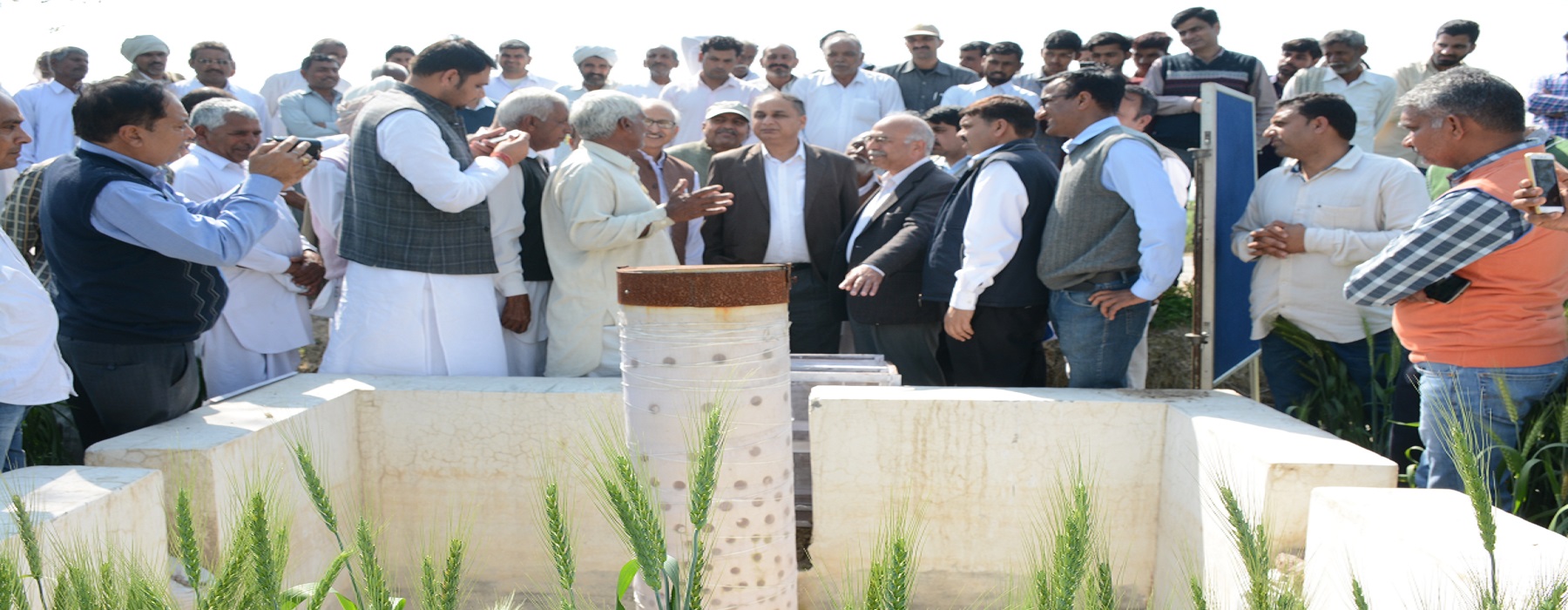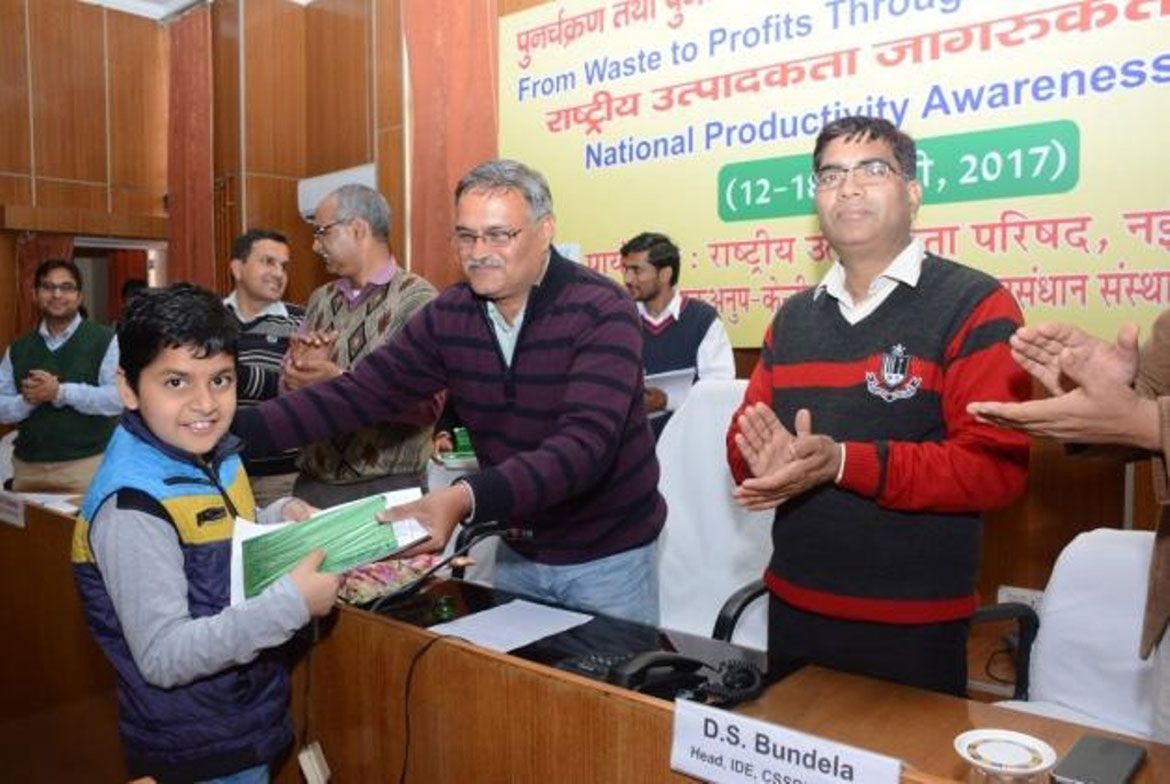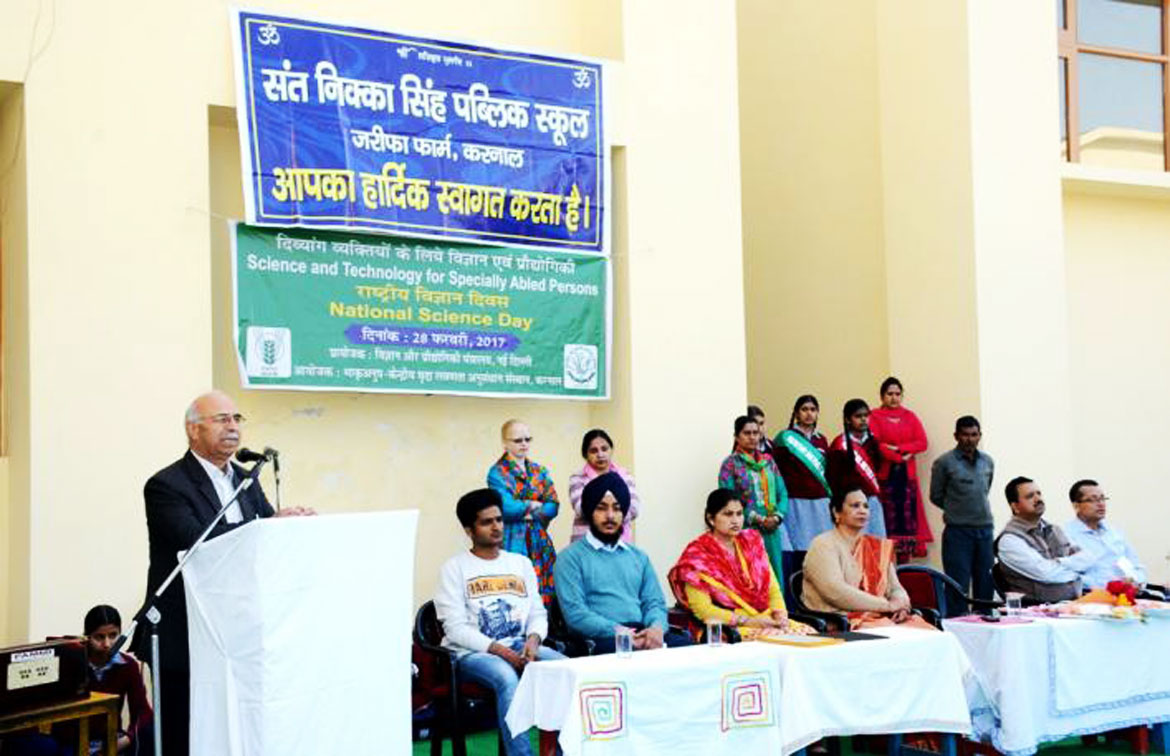Our Technology

About Centre
The salt affected soils are an important ecological entity in the landscape of any arid and semi-arid regions in India; such problematic soils occupy nearly 6.73 million ha and represent a serious threat to our ability to provide food, livelihood security of the burgeoning population.
However, in Uttar Pradesh the salt affected soils accounts for about 1.37 million ha. The majority of these soils are having pHs > 10, exchangeable sodium percentage (ESP) >15 and varying electrical conductivity (EC). The soil sodicity is a serious problem of the Indo-Gangetic plain affecting the productivity and livelihood of the people. In order to combat the challenges and threat posed due vast area of salt affected soils in Uttar Pradesh and Bihar, Indian Council of Agricultural research (ICAR) had decided to establish a Regional Research Station of CSSRI, Karnal at Lucknow during IX Five-year plan and it was formally established on 27 October, 1999. Since its inception, the institute has been pursuing interdisciplinary research on reclamation and management of salt affected and waterlogged soils. The centre has now grown into an internationally recognized centre of excellence in salinity research. The following were the main areas of investigation.
- Alkali land reclamation for crop production through agro-chemical methods.
- Reclamation and management of waterlogged soils
- Horticulture and Agro-forestry
- Improving sustainability of crop production through use of salt tolerant varieties.
Location and Climate
The present location of office cum laboratory building of Central Soil Salinity Research Institute, Regional Research Station, Lucknow is at old Jail Road, Near Manyawar Kanshiram Smarak Sthal, Alambagh while its experimental research site (Shivri Farm) is located at Mohan Road, Lucknow. It lies in the Central part of the Indo-Gangetic Plain with an average rainfall of 800 mm of which the majority of rainfall occurs during July-September. The groundwater table depth of the research site fluctuates seasonally between 5-7 m. Baring the months of july and August, the evaporation exceeds rainfall. The soils are classified as Typic Natrustalfs
Mandate
The RRS, Lucknow was established with the following mandate:
-
To develop appropriate hydraulic/agrochemical/biological technologies for reclamation/amelioration of relatively heavier sodic soils of central Indo-Gangetic plains, with surface drainage congestion and high water table,
-
To conduct research on use of sodic (high RSC) water and agro-industrial effluents,
-
To collaborate with regional agencies for achieving the above goals and
-
To act as a centre of training in sodicity/salinity research in the region and provide consultancies.
Achievements
Management of water logged sodic soils
About 0.35 million ha sodic lands suffer from shallow water table conditions in Sarda Sahayak Canal Command and are not suitable for cultivation even after conventional method of gypsum based reclamation. This has led to diminishing water productivity and loss of livelihood for the farm families in this command.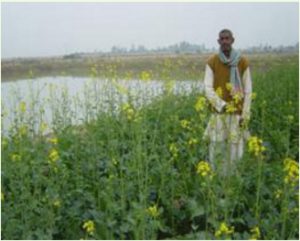
To address a land reclamation model for 1 ha based on the concept of physical land reclamation and pond based integrated farming system has been developed. A model of 1 ha comprising of 0.40 ha fish pond up to 1.75 m depth, 0.2 ha cereal crop, 0.15 ha fruit crop, 0.10 ha for vegetable and 0.10 ha for forage crops. The excavated soil was spread over the 0.6 ha land so that field can be raised at least 2 m from the water table. Through intervention of above land modification technique the productivity of the land and water increased many folds.
Alternate source of mineral gypsum for sodic soil reclamation
Phosphogypsum a byproduct of the phosphate fertilizers have been identified as an alternative source of the mineral gypsum. 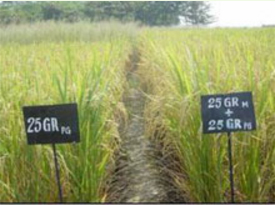 The application of phosphogypsum was better than the mineral gypsum regarding the reclamation of the sodic soil without any pollution effect on soil and water.
The application of phosphogypsum was better than the mineral gypsum regarding the reclamation of the sodic soil without any pollution effect on soil and water.
One time application of phosphogypsum (equivalent to 25 % mineral gypsum) + 25 % mineral gypsum or phosphogypsum (equivalent to 50 % mineral gypsum) can be used for sodic soil with higher of pH > 10.
Flushing technique for reclamation ong>
Soil testing facility for the resource poor farmers of sodic soil area, either unavailable or costly and time consuming, to address this problem a field kit with color charts was developed to test soil sodicity qualitatively right at the field or at farmers door step with the help of the kit the soil can be categorized into three groups i.e. Non sodic, Moderate sodic and Sodic and accordingly doses of the gypsum can be decided for the reclamation. The technical literature published by Director was distributed among the farmers and extension workers.
Resource conservation
Development of resource conservation technologies under sodic soils to increase the potentiality of yield and to conserve energy and money was very essential.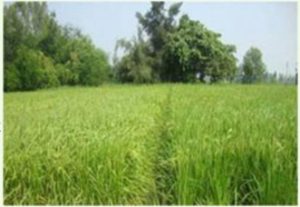
Adoption of the zero tillage in wheat and direct seeded in rice cultivation with 30% crop residue not only produced more grain yield in comparison to conventional method but also significantly improved physico-chemical of the soil.
Research for the past 30 years in sodiome important reclamation methodologies for the top 0-15 cm of soil with gypsum and cultivation of paddy and wheat resistant varieties for providing food security to the farmers of sodic soils. 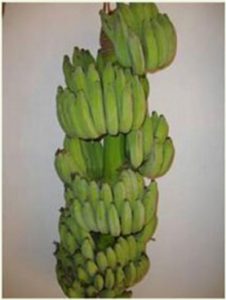 In the growing economy apart from providing food security it is obvious to provide economic and nutritional security to the farmers of sodic soils. Sub soil sodicity management technologies in banana in soil with pH range of 9.0 at the surface to 9.47 at sub-surface was developed.
In the growing economy apart from providing food security it is obvious to provide economic and nutritional security to the farmers of sodic soils. Sub soil sodicity management technologies in banana in soil with pH range of 9.0 at the surface to 9.47 at sub-surface was developed.
Apllication of 25% phospgypsum in combinations with vermicompost, mulch and CSR-B-1 strain of Bacillus sp isolated from sodic soils of Rae Bareli districtreduced th pH to 8.84 which resulted in higher bunch weight of 25 kg.
Alternate land use management technique for sodic soil
To study the performance of the different tree species in highly sodic soils, ten multipurpose tree species like Terminalia arjuna, Azardiracta indica, Prosopis juliflora, Pongamia pinnata, Cassurina equisetifolia etc were evaluated over the period of 10 years for economic and soil amelioration properties with various intercrops like Rhodes grass, Karnal gras etc under different agro forestry systems. Among them the Accacia nilotica + Rhodes grass was found to be an ideal silvi-pastoral system evaluated for the sodic soils of central Indo-Gangetic plain. This system is not only hasten the reclamation process but also comparatively more remunerative.
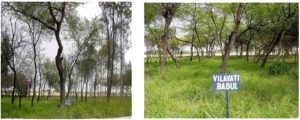
Screening of rice germplasm for sodicity is being underataken by the station under following programmes.
- IRSSTON – International Rice Soil Stress Tolerance Observational Nursery
- SATVT – Saline / Alkaline Tolerant Varietal Trial.
- NSASN – National Salinity / Alkanity Screening Nurersery.
- AICWIT – All India Co-ordinated Wheat Improvement Trial.
- AISATNT – All India Salinity / Alkalinity Tolerance Nuersery Trial on wheat.
On going Projects
Institutional Projects
-
Land modifications for increasing water productivity by different farming systems in partially water logged sodic soil along the Sarda Sahayak Canal Command
-
Study on salt and water dynamics and crop performance in water logged soil under raised and sunken beds
-
Resource conservation for rice wheat cropping system through intervention of tillage and crop residue management in partially reclaimed Indo-Gangatic sodic soil
-
Identification of genotypes in cactus, banana and aonla for tolerance to sodicity and standardization of management practices for economic livelihood in the resource poor sodic lands
-
Performance of Prosopis species under different amendments on sodic soil
Externally Funded:
-
Impact assessment of climate change on crop production and soil condition under salt affected environment of Uttar Pradesh
-
Holistic approach for improving lively hood security to livestock based farming systems in Barabanki and Raibareli District of Uttar Pradesh
-
Farmer’s Participatory Research on Enhancing Ground Water Recharge and Water Productivity in North West India
-
Stress tolerant rice for poor farmers in Africa and south Asia under BMGF project
-
All India Co-ordinated Trials
- Screening of rice
- Screening of wheat
- Screening of linseed
- Screening of gram
Technologes
Holistic approach for improving livelihood security through livestock based farming system in Barabanki and Raebareli districts of U.P. – NAIP-III project
A NAIP-3 Sub-project entitled as above is being implemented in Barabanki and Raebareli districts of Uttar Pradesh to address the challenge of poverty alleviation with need based integration of technologies developed in Specialized IFS models which can be replicated and implemented in other parts of the country with similar ecology and social status. About 400 farmers were covered as bene programme with technological interventions like sodic soil reclamation, zero tillage in wheat, commercial banana and vegetable cultivation etc. Some of the successful interventions are:
-
Sodic soil patches in Lalganj block covering four villages Bachewakapuruva, Dayaplpur, Orikapuruva and Haripur in Raebareli districts has been a serious bottle neck in creating livelihood security. These soils were reclaimed using phospogypusum technology and first crop of summer daincha and paddy var.CSR-36 were intervened. These beneficiaries were successfully linked with rural backyard poultry production with azolla as feed supplement. The sodic lands farmers were also intervened with guava under high density system. Under intensive system guava (3 x 1.5 m).
-
About 30 farmers adopted the technology where banana cultivation is being coupled with crops like moong bean and black gram during summer followed by early tomato, cabbage and cauliflower in monsoon to afford the resource poor farmers to spend for the inputs for their main crop banana and also the technology was furthered strengthened with on farm vermicomposting, mass multiplication of Psuedomonads and Trichoderma. The technology of rural poultry production was also integrated for providing sustainable livelihood. The average income of the farmers who had adopted banana cultivation with composting is about Rs.1, 34,444/- from an area of half an acre.
On Farm Demonstration
On Farm demonstration of salt tolerant rice, wheat cultivar, ground water recharge under participatory mode is being initiated under SRASA, FPRP and BGREI programme.
Extension and Information Service
-
Training Programmes
-
Village Extension Programme for Integrated Rural Development
-
Farmers Mela
-
Off-Campus training camps
-
Orientation Programmes
-
National Workshop/ Convention/Seminar
-
Training for Post Graduate Students
-
Consultancy services in the field of sodic soil, saline water and crop management, agricultural drainage and soil testing.
-
Guiding research scholar for post graduate / Ph.D. programme
Laboratory facilitie
Soil Chemistry
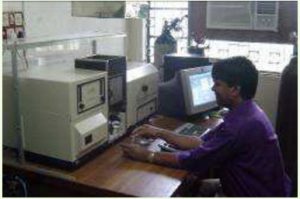
Soil Physics
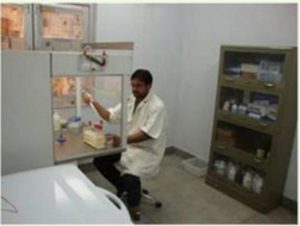
Microbiology
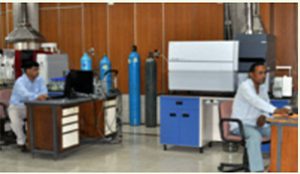
Our Technology
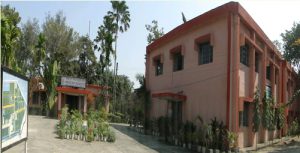
About Centre
The station has a campus of an approximate area of 26 hectare of land on the bank of the estuarine river Matla. It has 3 adjacent units viz. Laboratory/ Office, residential quarters and experimental farm.
Building
Regional Research Station, Canning Town has two main buildings units, one is for administrative offices and the other for modern research laboratory. Besides there are other buildings viz. Workshop, Stores, Meteorological Observatory, Glass House and residential quarters.
Farm
Out of the total 26 hectare of land about 12 hectare is old experimental farm area and about 14 hectare is the new experimental farm area located on the silted bed of the estuarine river Matla flowing brackish water round the year. The farm is equipped with modern farm machineries and facilities like tractor, power-tillers and diesel engine pumps, electrical pumps, drip irrigation system and micro-sprinkler irrigation system, irrigation ponds, deep-tubewells, etc.
Laboratory
The building has different laboratory units like Soil Physics, Soil Chemistry, Agricultural Engineering, Agricultural Extension, Agricultural Economics, Plant Breeding, Agronomy and Plant Physiology.

The laboratories are well equipped with the instruments such as Atomic Absorption Spectro Photometers (AAS) (Fig.2), UV-Spectrophotometer, Automatic Nitrogen Analyzer, Flame Photometer, Electronic Digital Balances, Pressure Plate Apparatus, Neutron Probe-moisture meter, digital pH Meters, digital Conductivity Meters, ODR Meter, Water level indicator, Lysimeter, Dumpy level, Pantograph, Deep-freeze, Centrifuge, GPS, etc. The computers of the laboratories are connected trough LAN. There are advance facilities like Internet system through VSAT, data loggers, scanners, LCD Projector, Handy cam, Digital Camera, etc.
Meteorological observatory
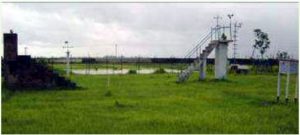
The meteorological observatory of the Regional Research Station is having all the necessary equipments for measuring standard weather parameters (Fig.3). Trained and experienced staff members of this station and IMD are engaged for recording and communicating the daily
Achievements:
- Soil Management
Characterization of coastal soils: Coastal soils of eastern coast perticulerly of West Bengal and Orrisa have been studied. Coastal soils of West Bengal (in the Ganges delta) are classified under different pH and salinity (Fig.4) groups. These soils are usually near neutral in reaction with varying salinity levels. The soil salinity shows highly temporal and spatial variability. The available nutrient status of the soils are: low in N, medium to high in P, high in K and micronutrients except Zn.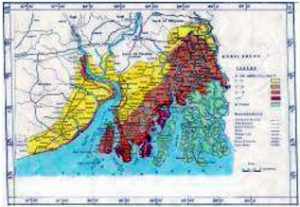
The soils are rich in soluble salts of Cl, Na+, Ca2+ and Mg2+ and K+ . The soils are usually heavy to medium in texture with moderate CEC and water holding capacity. The lands are gently sloped and typically characterized by its higher soluble salt contents in the rhizosphere, presence of brackishwater aquifer at close proximity to the surface and poor drainage condition. The soils are, in general, classified as Inceptisol and Entisol in the order level. Based on soil characteristics the location specific management.
Management of acid sulphate soil: Acid sulphate/ acid saline soils are present in the delta region of several major rivers in the coastal areas. These soils are highly under-utilized. Besides liming, higher doses of P-fertilizer is essential for proper management of these soils. Rock phosphate or locally available oyster shell (available in coastal region) along with green manures/ leaf manures may be used for achieving higher yield of crops on these soils.
- Nitrogen management of soil: Volatilization loss of applied N-fertilizer is high in coastal salt affected soils and accounts for a loss as high as 30-50%. Loss of N increases with salinity and loss could be substantially reduced by placement (5cm) of N-fertilizer in soil either directly or in paper packet or in the form of briquettes. The efficiency of N-fertilizer is much improved on using it in conjunction with manures/green manures or any locally available organic materials such as leaves of trees, farm waste, etc.
- Phosphorous and potassium management of soil: The coastal soils are generally rich in available P and K. Long-term experimental results indicated that even if there is no response of P-fertilizer a basal application of 6-11 kg P ha-1, depending on crop type is required to maintain P-fertility level of soils. Application of K-fertilizer, which is mainly imported commodity, may generally be omitted.
- Integrated nutrient management (INM):
The results of on-farm (Fig.5) and experimental field trials conducted simultaneously in West Bengal, Orissa, Andhra Pradesh. and Tamil Nadu, indicated that 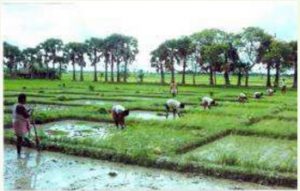 yield of crops was better when combined sources (organic and inorganic) of nitrogen were applied. Addition of Sesbania, Gliricidia, city compost and leaves of locally available trees alongwith inorganic N-fertilizer improved crop yield and soil health. Use of bio-fertilizers particularly for rabi/ summer crops was quite beneficial.
yield of crops was better when combined sources (organic and inorganic) of nitrogen were applied. Addition of Sesbania, Gliricidia, city compost and leaves of locally available trees alongwith inorganic N-fertilizer improved crop yield and soil health. Use of bio-fertilizers particularly for rabi/ summer crops was quite beneficial.
- Managing the damage of rabi/summer crops due to heavy showers: Extensive damages of crops due to heavy showers in rabi/summer are one of the great hindrances for second crop cultivation. Reduce oxygen diffusion in rhizosphere soil and excess availability of Fe in soil are the root causes of damage. Aerating soil between rows through raking, providing drainage and higher dose of P-fertilizer can alleviate the damage.
- Managing salinity build up in soil: Strategies like growing crops with large foliage cover, mulching with rice husk/ rice straw or any organic waste are very effective to decrease large accumulation of salts during dry season.
- Managing rice field against toxic gases: Formation of hydrogen sulphide (H2S) gas due to sulphate reduction may lead to low rice yield and environmental pollution. Occasional stirring of rice soil in between rows will release H2S in air and reduce crop damage.
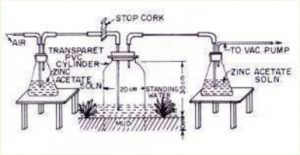
In case of acute damage of crop due to H2S excess Fe-fertilizer may be applied. A simple estimation for H2S released from rice field was developed as shown given in Fig.6. Production of methane (CH4) in rice field causing environmental pollution was found to reduce by application of Calcium Carbide encapsulated N-fertilizer.
- Changes in coastal land following introduction of brackishwater fisheries: In the recent years large areas of agricultural fields in the coastal areas of the country, particularly in the state of West Bengal are being converted into brackishwater fish and prawn farms for higher remunerations. It was observed that due to the brackish water fisheries the soil salinity of adjacent crop fields increased and there was a decrease in yield. The influence was prominent up to a distances of 50 m. The soil salinity of brackishwater fish farm also increased with the increase in the salinity of water. Available iron and manganese content in soil was quite high in the adjoining crop fields and more so in the brackishwater fish farms. When a brackishwater fish farm was reconverted to agricultural fields, the oxidation of sulphidic materials in soil may produce high acidity and toxic availability of Fe, Al and Mn
- Water Management
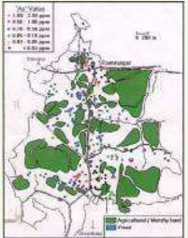 Managing arsenic contaminated water for irrigation: Ground water at shallow depth (<125 ft) at many locations in Baruipur block, (in coastal West Bengal) South 24 Parganas contains toxic levels of As (0.05-2.5 ppm), while surface water and underground water at depth >250 ft are usually free from arsenic (Fig 7.). Consumption of crops, particularly root crops and leafy vegetables grown on arsenic affected soil/water is harmful for human health. Soil rich in arsenic should be additionally fertilized with Fe or Zn to induce arsenic fixation, while application of P-fertilizer, organic manures and submergence of soil should be
Managing arsenic contaminated water for irrigation: Ground water at shallow depth (<125 ft) at many locations in Baruipur block, (in coastal West Bengal) South 24 Parganas contains toxic levels of As (0.05-2.5 ppm), while surface water and underground water at depth >250 ft are usually free from arsenic (Fig 7.). Consumption of crops, particularly root crops and leafy vegetables grown on arsenic affected soil/water is harmful for human health. Soil rich in arsenic should be additionally fertilized with Fe or Zn to induce arsenic fixation, while application of P-fertilizer, organic manures and submergence of soil should be
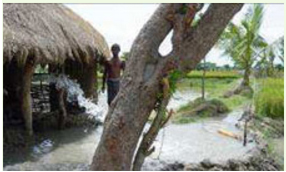 Irrigation with tubewell water:
Irrigation with tubewell water:
Water of some of the shallow tubewells in Sunderbans region was found suitable (EC <2 dSm-1) for irrigation. Economic analysis indicated marginal profit from rabi/summer paddy cultivation irrigated with the tube-wells (Fig.8.) The economics of water use could be increased by cultivating crops other then paddy, which require less water
 Growing crops under micro-irrigation systems: Ladies’ finger yielded more under drip irrigation at IW/CPE ratio 1.0 than IW/CPE ratio 0.5 and conventional method. The efficiency of irrigation system was 86.6%. There was almost 30 percent more yield of Ladies finger crop under micro-sprinkler irrigation (Fig.9) than the conventional method. The best yield was found for the micro-sprinkler
Growing crops under micro-irrigation systems: Ladies’ finger yielded more under drip irrigation at IW/CPE ratio 1.0 than IW/CPE ratio 0.5 and conventional method. The efficiency of irrigation system was 86.6%. There was almost 30 percent more yield of Ladies finger crop under micro-sprinkler irrigation (Fig.9) than the conventional method. The best yield was found for the micro-sprinkler
- Salt and water flux: For leaching 70% of salt from 0-30 cm depth leaching requirement (LR) for most cereals and vegetables should be 0.90 cm cm-1 and for tolerant crops, it should be between 0.75 and 0.60 cm cm-1 soil depth. A model on 2-dimentional flux of salt and water in soil was established under simulated trickle irrigation.
Multiple crop cultivation and diversification through land shaping
- Land shaping for deep furrow & high ridge cultivation:
The 50% of farm land may be shaped into alternate furrows (3m top width × 1.5 m bottom width × 1.0 m depth) and ridges (1.5 m top width ×1.0 m height × 3m bottom width) (Fig. 10). The ridges remain relatively free from drainage congestion and low in soil salinity build up.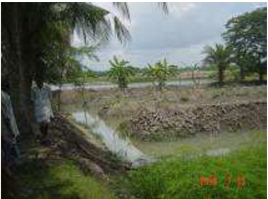
Thus ridges can be used for multiple crop cultivation and the furrows are useful for rainwater harvesting and fish cultivation along with rice (on remaining 50% of original low-land) during wet season.
During dry season the ridges continued to be used for vegetable/fruit cultivation. The remaining original fields are used for low water requiring field crops with the rain water harvested in the furrows.
- Land shaping for shallow furrow & medium ridge cultivation:
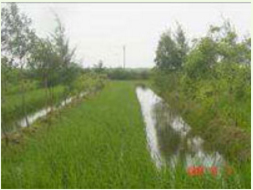 About 75 % of the farm land may be shaped into furrows (2.0m top width × 1.0 m bottom width × 0.75 m depth) and medium ridges (1.0 m top width ×0.75 m height × 2.0m bottom width) with a gap of 3.5m between two consecutive ridges and furrows. Thus, there will be three land situations viz. low land (medium furrow), midland (original farm land) and high land (ridge)
About 75 % of the farm land may be shaped into furrows (2.0m top width × 1.0 m bottom width × 0.75 m depth) and medium ridges (1.0 m top width ×0.75 m height × 2.0m bottom width) with a gap of 3.5m between two consecutive ridges and furrows. Thus, there will be three land situations viz. low land (medium furrow), midland (original farm land) and high land (ridge)
The furrows can be used for rainwater harvesting as well as fish cultivation along with paddy in wet season. In dry season furrows can be used for rice cultivation. The ridges are free from waterlogging in wet season and suitable for cultivation of crops other than rice throughout the year. The original land is used for growing low water requiring.
- Land shaping for farm pond:
The water balance analysis shows considerable scope for conservation of excesses rain water in on-farm reservoir (OFR). 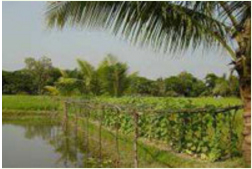 Soil water balance model developed for rainfed rice cultivation showed that about 20% of watershed/ farm area may be converted to OFR (Fig. 12) to harvest excess rain water for utilizing to grow crops in rabi/summer, supplemental irrigation in kharif and freshwater aquaculture. The dug-out soil was used to raise the land to form high and medium land situations for growing multiple crops including
Soil water balance model developed for rainfed rice cultivation showed that about 20% of watershed/ farm area may be converted to OFR (Fig. 12) to harvest excess rain water for utilizing to grow crops in rabi/summer, supplemental irrigation in kharif and freshwater aquaculture. The dug-out soil was used to raise the land to form high and medium land situations for growing multiple crops including
- Land Shaping for paddy-cum-fish cultivation:
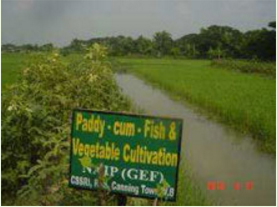 Trenches of about 3 m width X 1.5 m depth are dug around the field with a ditch of 6m X 6m X 3m(depth) at one corner. The excavated soil is used for making dikes of about 3 m width X 1.5 m high around the field to protect the fishes to be grown in paddy-cum-fish cultivation (Fig. 13). During kharif paddy-cum fish is grown on the original low land and vegetables on the dikes.
Trenches of about 3 m width X 1.5 m depth are dug around the field with a ditch of 6m X 6m X 3m(depth) at one corner. The excavated soil is used for making dikes of about 3 m width X 1.5 m high around the field to protect the fishes to be grown in paddy-cum-fish cultivation (Fig. 13). During kharif paddy-cum fish is grown on the original low land and vegetables on the dikes.
During rabi/summer low water requiring field crops & vegetables are continued to be grown on the dikes, and low water rquring crops on the original land with live saving irrigation given with rain water harvested furrows. Otherwise the original lands may also be used for brackish water fish cultivation. At the end of the summer season the brackish water is drained out with the help of pre-monsoon rains. The land is again used for Paddy-cum-fish cultivation.
- Crop Improvement and diversification
Crop varieties: Eradication of soil salinity and amelioration require a large expenditure, which is difficult to afford. Therefore, manipulation of the genotypes is used to suit the existing soil and water constraints. The salt tolerant high yielding varieties of rice and other crops developed/ identified by this station. The promising rice varieties developed/identified for rabi/summer and kharif seasons are given in Table 1&2.
Table 1. Improved varieties of rice for rabi/summer
| Salinity | Varieties |
| Level* | |
| Low | CSR 4,Canning 7, Ratna, Khitis, Rasi, Body, IR 7634, IR 75395 |
| Medium | CSR 4, Canning 7, CST 7-1, CSRC(S) 7-10-4-0-1,Lalminikit (WGL 20471) |
| Bidhan 2, Annada, Lalat, CSRC(S) 39-1-B-2, CSRC(S) 47-7-B-B-1 |
* Soil salinity (ECe,dS m-1) : Low < 6.0, medium 6.0-8.0
Table 2. Improved varieties of rice for kharif
| Water | Soil | Varieties |
| Regimes
Up to 15 cm |
Salinity
Medium to high |
Early: CSR4, Canning 7, IET 1444, CSRC(S)7-10-2-0 |
| (up land)
15-30 (Shallow Water) |
Low To medium | Medium: CST7-1, Jaya, CSR 1, CSR 2, CSR 3
Medium: CSR 6, SR26B, CS9-1-30, Dudheswar, CSRC(S)21-2-5-B-1-1 Late: NC1281, NC678, Matla , Hamilton, Najani, Jhingasail, C300, BD50-11, C340-22-17, Gavir Saru, Gopal Bhog,C300, BD50-11, C340-22-5 |
| 30-50 cm(semi-Deep water) | Low To Medium | Medium: CSRC (S) 2-1-7, SR 26B,CSR6, IR 16294, CS 9-1-30, Amalmana (CSRC(S) 7-1-4), Geetanjali, SR 26B, Pankaj, Sabita, Patnai 23
Late: C300, BD50-11, C340-22-17, C340-22-5, NC 1281, Matla, Hamilton, Asfal, Gavir Saru, NC 678 |
| Acid Saline Soils (pH 4.0-5.5), salinity Medium | Medium: Mahsuri, Canning 7, SR 26B, K.D.Mail | |
| Flash Floods | CAC615, CSR6, SR26B, Swarna Sub-1 |
Salt tolerant vegetable, fruit, fodder and agroforestry crops:
-
Coix was identified as a fodder crop tolerant to waterlogging and high salinity.
-
Chilli can be grown profitably at soil salinity (ECe) up to 7 dSm-1 and cotton up to 13 dSm-1.
-
Guava and particularly sapota (Fig.14) are suitable fruit crops under high salinity.
-
Sweet potato can be grown under high salinity.
-
Suitable agroforestry species that can be grown after some land shaping are:
Eucalyptus sps., Acacia auriculiformis, Casuarina sps., Heritiera fomes, Brugeria gymnorhiza & Xylocarpus mekongensis
Suitable mangrove forest species identified for non-tidal coastal saline soils are:
-
Avicennia, Xylocarpus, Excoecaria, Brugaria and Heretiera
-
Spices like Fennel, Nijella sativa and coriander can be grown in the salt affected coastal land.
-
Suitable aromatic crops are Cymbopogon flexuous, Alovera sp., Cymbopogon flexuous and Cymbopogon martini.
-
Rauwolfia serpentina L. (Swarpagandha ), Isabgol (Plantago Ovata) were identified as promising medicinal plants for coastal region
Crop calendar: 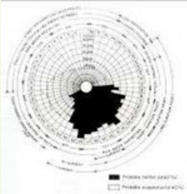 A crop calendar (Fig.14) has been devised accommodating a large number of crops considering weather, soil salinity, water requirement, etc. for crop production throughout the year. The crops to be cultivated in a perticuler area can be selected with the help of the crop calendar and depending on the soil salinity and irrigation water available
A crop calendar (Fig.14) has been devised accommodating a large number of crops considering weather, soil salinity, water requirement, etc. for crop production throughout the year. The crops to be cultivated in a perticuler area can be selected with the help of the crop calendar and depending on the soil salinity and irrigation water available
Criteria identified for salt tolerance of crops:
-
Lower Na/K ratio in plant tissue
-
Smaller variation in stomatal frequency
-
Lesser variation of leaf water potential with salt stress
-
Presence of epidermal hairs or trichomes
-
Higher dehydrogenase activity and stomatal resistance with increased salinity.
-
A weak band of high molecular weight of 90 Kda polypeptide.
For more detailed information please contact:
Head, CSSRI, RRS, Canning Town,
South 24-Parganas, West Bengal, India, PIN-743329,
Telephone : 03218-255241/255085, Fax: 03218-255084,
E-mail: cssri.canning@gmail.com
Web: www.cssri.org
A passion for planning, enjoy putting their plans into action.
Lorem ipsum dolor sit amet, consectetur adipiscing elit. Fusce scelerisque iaculis libero, ac pellentesque mi fermentum vitae. Donec ipsum tellus, dapibus at blandit sed, iaculis quis est. Maecenas luctus facilisis lacus, et aliquet arcu cursus vitae. Nulla dolor erat, iaculis in gravida quis, pellentesque sed tortor. Aliquam varius euismod orci venenatis tincidunt. Interdum et malesuada fames ac ante ipsum primis in faucibus. Duis vel pharetra metus, ut pretium mi. Nunc at dolor eros. Aenean tempor viverra risus sit amet condimentum. Nulla facilisi.
Event involves the planning of all kinds of events.
Lorem ipsum dolor sit amet, consectetur adipiscing elit. Fusce scelerisque iaculis libero, ac pellentesque mi fermentum vitae. Donec ipsum tellus, dapibus at blandit sed, iaculis quis est. Maecenas luctus facilisis lacus, et aliquet arcu cursus vitae. Nulla dolor erat, iaculis in gravida quis, pellentesque sed tortor. Aliquam varius euismod orci venenatis tincidunt. Interdum et malesuada fames ac ante ipsum primis in faucibus. Duis vel pharetra metus, ut pretium mi. Nunc at dolor eros. Aenean tempor viverra risus sit amet condimentum. Nulla facilisi.
Event involves the planning of all kinds of events.
Lorem ipsum dolor sit amet, consectetur adipiscing elit. Fusce scelerisque iaculis libero, ac pellentesque mi fermentum vitae. Donec ipsum tellus, dapibus at blandit sed, iaculis quis est. Maecenas luctus facilisis lacus, et aliquet arcu cursus vitae. Nulla dolor erat, iaculis in gravida quis, pellentesque sed tortor. Aliquam varius euismod orci venenatis tincidunt. Interdum et malesuada fames ac ante ipsum primis in faucibus. Duis vel pharetra metus, ut pretium mi. Nunc at dolor eros. Aenean tempor viverra risus sit amet condimentum. Nulla facilisi.
Do you have a passion for organizing and meeting new people?
Lorem ipsum dolor sit amet, consectetur adipiscing elit. Fusce scelerisque iaculis libero, ac pellentesque mi fermentum vitae. Donec ipsum tellus, dapibus at blandit sed, iaculis quis est. Maecenas luctus facilisis lacus, et aliquet arcu cursus vitae. Nulla dolor erat, iaculis in gravida quis, pellentesque sed tortor. Aliquam varius euismod orci venenatis tincidunt. Interdum et malesuada fames ac ante ipsum primis in faucibus. Duis vel pharetra metus, ut pretium mi. Nunc at dolor eros. Aenean tempor viverra risus sit amet condimentum. Nulla facilisi.
Event involves the planning of all kinds of events.
Lorem ipsum dolor sit amet, consectetur adipiscing elit. Fusce scelerisque iaculis libero, ac pellentesque mi fermentum vitae. Donec ipsum tellus, dapibus at blandit sed, iaculis quis est.Maecenas luctus facilisis lacus, et aliquet arcu cursus vitae. Nulla dolor erat, iaculis in gravida quis, pellentesque sed tortor. Aliquam varius euismod orci venenatis tincidunt. Interdum et malesuada fames ac ante ipsum primis in faucibus. Duis vel pharetra metus, ut pretium mi. Nunc at dolor eros. Aenean tempor viverra risus sit amet condimentum. Nulla facilisi.
Event involves the planning of all kinds of events.
Lorem ipsum dolor sit amet, consectetur adipiscing elit. Fusce scelerisque iaculis libero, ac pellentesque mi fermentum vitae. Donec ipsum tellus, dapibus at blandit sed, iaculis quis est. Maecenas luctus facilisis lacus, et aliquet arcu cursus vitae. Nulla dolor erat, iaculis in gravida quis, pellentesque sed tortor. Aliquam varius euismod orci venenatis tincidunt. Interdum et malesuada fames ac ante ipsum primis in faucibus. Duis vel pharetra metus, ut pretium mi. Nunc at dolor eros. Aenean tempor viverra risus sit amet condimentum. Nulla facilisi.
The clean typography and awesome white layout
Lorem ipsum dolor sit amet, consectetur adipiscing elit. Fusce scelerisque iaculis libero, ac pellentesque mi fermentum vitae. Donec ipsum tellus, dapibus at blandit sed, iaculis quis est. Maecenas luctus facilisis lacus, et aliquet arcu cursus vitae. Nulla dolor erat, iaculis in gravida quis, pellentesque sed tortor. Aliquam varius euismod orci venenatis tincidunt. Interdum et malesuada fames ac ante ipsum primis in faucibus. Duis vel pharetra metus, ut pretium mi. Nunc at dolor eros. Aenean tempor viverra risus sit amet condimentum. Nulla facilisi.


